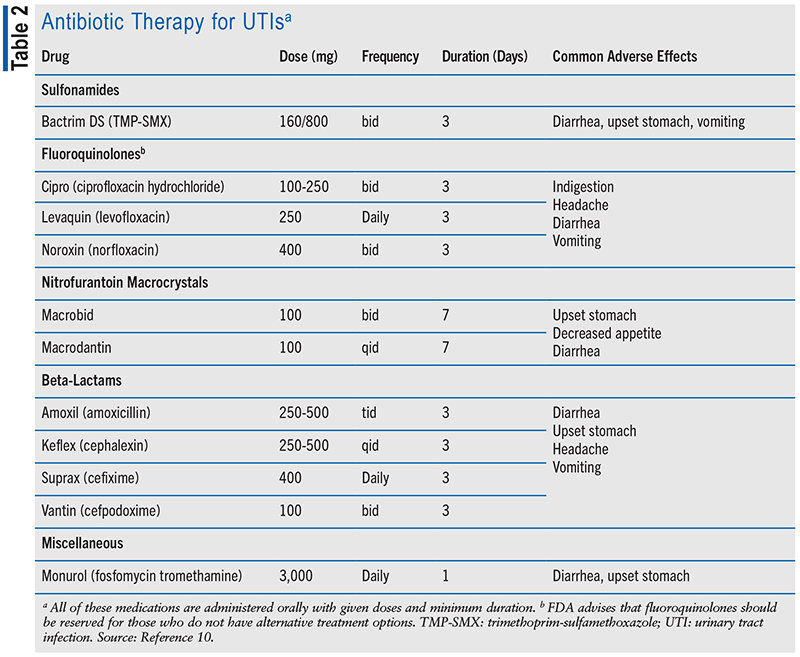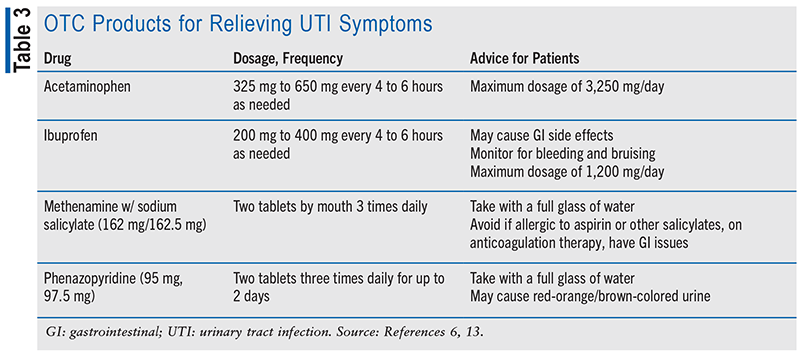US Pharm. 2023;48(4):8-13.
ABSTRACT: It can be challenging for patients to determine whether they have a urinary tract infection (UTI). UTIs most frequently occur in the bladder and urethra and can be classified as either uncomplicated or complicated. The majority of difficult UTI cases in hospitals occur as a result of urinary catheters. Women who are healthy, are youthful, and have an unobstructed genitourinary tract frequently get uncomplicated UTIs. Pharmacists must be prepared to inform patients about the distinctions between various types of UTIs and how to treat them, emphasizing the importance of adherence to therapy and prevention.
Urinary tract infections (UTIs) are among the most common outpatient infections, affecting more than 50% of adolescent women in their lifetime.1 In 2015, there were an estimated 62,700 UTIs in acute-care hospitals, accounting for more than 9.5% of infections reported by acute-care hospitals.2 A UTI consists of an infection in any part of the urinary system, including the kidneys, ureter, bladder, and urethra. Most infections involve the lower urinary tract—the bladder and the urethra. The occurrence of a UTI begins with uropathogens. Uropathogens contain specialized characteristics, such as the production of adhesins, siderophores, and toxins that allow for them to colonize and invade the urinary tract. These pathogens are transmitted between individuals through person-to-person contact or via food or water.3 Many causative agents are gram-positive and gram-negative bacteria. The gram-negative bacterium Escherichia coli accounts for almost 90% of all episodes. Other common causative agents include Staphylococcus saprophyticus, Klebsiella pneumoniae, Enterococcus faecalis, group B streptococcus, Proteus mirabilis, Pseudomonas aeruginosa, Staphylococcus aureus, and Candida species.
Causes and Risk Factors
UTIs occur in the urinary system and are classified as either uncomplicated or complicated (see TABLE 1). Uncomplicated UTIs are found commonly in women who are healthy, are young, and have an unobstructed genitourinary tract. Complicated UTIs occur when the infection is beyond the urinary tract to the kidneys due to pregnancy, urinary retention or obstruction caused by immunosuppression, renal failure, or renal obstruction.4 Increased sexual activity with new partners, certain birth control methods (such as diaphragm use in women and spermicidal agents in men), and menopause are additional risk factors for developing a UTI in women.5 Patients who are hospitalized mainly develop UTIs through indwelling urinary catheters. Indwelling urinary catheters are one of the common causes in complicated UTI and occur in 70% to 80% of these cases in the United States per year.6 Complicated UTIs are found in both men and women and can be further categorized as upper UTI (pyelonephritis) and lower UTI (cystitis). Pharmacists can determine prediagnostic symptoms of UTIs and provide consultation regarding recommendation for OTC products or whether doctor referral is required.

Symptoms and Diagnosis
Since an infection does not always generate symptoms, it can be challenging to tell whether a patient develops a UTI. There are also occasions in which a UTI may be present; however, a test shows a negative result, leading to difficulty in diagnosis. There are many common symptoms that may imply the presence of a UTI before a diagnosis is confirmed. Some of the symptoms of an uncomplicated UTI are urinary frequency, urgency, discomfort in the suprapubic area, and dysuria.7 Typically, patients who experience uncomplicated UTIs do not encounter fever, chills, nausea, vomiting, or back pain. Those symptoms indicate kidney involvement or upper tract disease, also known as pyelonephritis.
When used properly, home UTI test strips (e.g., AZO) available OTC can aid in the detection of a UTI. These test strips can determine the presence of leukocytes and nitrites in the urine, indicating an infection. To avoid any false or incorrect results, patients must 1) obtain a clean catch urine specimen and 2) avoid taking more than 250 mg of vitamin C within 24 hours of testing, and 3) women should not test during their menses. It may also produce inaccurate findings if the patient is taking doxycycline or phenazopyridine or is on a strict vegetarian diet.6,8
Even with the use of at-home testing kits, it is still encouraged that patients visit their provider for an accurate assessment and evaluation. A prescriber can frequently determine the presence of a UTI simply by symptoms, without the need for testing. For instance, if a woman has symptoms of a bladder infection without vaginal itchiness or discharge, it is likely a UTI. In some situations, a urine culture and/or urinalysis are required to assist in the diagnosis of a UTI. A laboratory urinalysis will check for white blood cells and bacteria in the urine, with the urine culture identifying the type of bacterium that is causing the UTI in order to establish which medications are effective against it.9
Treatment Options
Since clinical symptoms of both simple and complicated UTIs sometimes overlap, it can be challenging to tell them apart at times. It is advisable in this situation to treat the illness aggressively to prevent any upper tract disease. If a UTI is present, a number of antibiotics can be recommended (see TABLE 2). Women who are able to take oral drugs and have acute, uncomplicated cystitis without fever, flank pain, or any other indication of pyelonephritis may use oral antibiotic treatment. Providers should take the patient’s allergy history, tolerance to the medication, and accessibility into account when prescribing an antibiotic regimen. Trimethoprim-sulfamethoxazole, fosfomycin, and nitrofurantoin are the primary oral antibiotic drugs used to treat UTIs. Fluoroquinolones or beta-lactams can be prescribed if none of the aforementioned medications are advised. Use of ampicillin or amoxicillin as monotherapy should be avoided since they are less effective than other available medications and necessitate closer therapeutic monitoring.10

Barriers in Obtaining Care and Treatment
Due to a number of obstacles, including financial constraints, illiteracy, lack of understanding of the infection, and antibiotic resistance, it can be challenging for patients to receive the best care available. Financial obstacles include the cost of OTC test strips, lack of prescription insurance, or lack of medical insurance. These types of expenses may be more than many patients can reasonably afford without insurance, deterring them from seeking treatment or confirming a diagnosis. Individuals with poor medical literacy might not fully comprehend their situation and potentially minimize the severity of the infection. Poor medication literacy can also result in patients not using their antibiotics properly, which can lead to suboptimal therapeutic effects, an inaccurate length of therapy, and possible antibiotic-related side effects. Inaccurate course of therapy can also result in antimicrobial resistance over time with difficulty in treating a recurrent UTI. Antimicrobial resistance is one of the most serious threats to public health. Patients with antibiotic-resistant UTIs are symptomatic for longer and cost more to treat in primary care.11 Due to these obstacles, a patient may neglect to seek medical attention for their UTI, leading to a more serious and even potentially life-threatening infection. Furthermore, untreated bladder infections have the potential to develop into kidney infections, which can subsequently spread to the bloodstream, leading to sepsis.
Pharmacist’s Role
Pharmacists are frequently consulted by patients for assistance on the signs, causes, and prevention of UTI. Patients with symptoms of a UTI should be advised to consult with their healthcare provider as soon as possible to obtain proper care. Pharmacists can inform and educate patients about the various nonprescription options available, including UTI home test strips and nonpharmacologic treatments. The role of heating pads is one method to assist in minimizing the discomfort patients experience with a UTI. Increasing water consumption, changing tampons frequently, urinating before and after sexual contact, and taking showers rather than baths are some other UTI-prevention strategies that can be discussed with patients. Patients should also be given instructions on how to use UTI home test strips to prevent erroneous and misinterpreted results. Patients should be informed about the recommended duration and maximum dosage strength before using OTC urinary tract analgesics (see TABLE 3). Patients should also be aware that these products will only stop the pain and other related symptoms until they see their provider. They should not be used as monotherapy since they will not treat the underlying infection or take the place of antibiotic therapy. Probiotics and cranberry supplements can perhaps prevent bacteria from adhering to the walls of the urinary system and can also be recommended, even though there are limited studies that demonstrate natural supplements can prevent UTIs.12 Finally, pharmacists must ensure that patients who have been diagnosed with a UTI and given antibiotic therapy are taking their medications properly, for the appropriate amount of time, and are aware of how to handle both common and serious side effects.

Conclusion
It can be challenging to determine whether a patient has a UTI. Based on given signs and symptoms, pharmacists can assist in differentiating between an uncomplicated or complicated UTI in patients. Antimicrobial therapy is indicated for treatment and dependent on various patient factors. Pharmacists need to be prepared in educating patients on the different types of UTIs, how to manage them, and the importance of adhering to their treatment and preventative regimens.
REFERENCES
1. Medina M, Castillo-Pino E. An introduction to the epidemiology and burden of urinary tract infections. Ther Adv Urol. 2019;11:1756287219832172.
2. CDC National Healthcare Safety Network. Urinary tract infection (catheter-associated urinary tract infection [CAUTI] and non-catheter-associated urinary tract infection [UTI]) events. January 2023. www.cdc.gov/nhsn/pdfs/pscmanual/7psccauticurrent.pdf. Accessed January 9, 2023.
3. Foxman B. The epidemiology of urinary tract infection. Nat Rev Urol. 2010;7(12):653-660.
4. Flores-Mireles AL, Walker JN, Caparon M, Hultgren SJ. Urinary tract infections: epidemiology, mechanisms of infection and treatment options. Nat Rev Microbiol. 2015;13(5):269-284.
5. Moore EE, Hawes SE, Scholes D, et al. Sexual intercourse and risk of symptomatic urinary tract infection in post-menopausal women. J Gen Intern Med. 2008;23(5):595-599.
6. Farzadeh SN, Ambizas EM. Urinary tract infections and self-care options. US Pharm. 2017;9(42):4-7.
7. Bono MJ, Leslie SW, Reygaert WC. Urinary tract infection. In: StatPearls [Internet]. Treasure Island, FL: StatPearls Publishing; 2022 Jan-.
8. AZO. AZO test strips. www.azoproducts.com/product/urinary-tract-infections/test-strips/. Accessed January 8, 2023.
9. Gupta K. Patient education: urinary tract infections in adolescents and adults (beyond the basics). UpToDate. August 11, 2022. www.uptodate.com/contents/urinary-tract-infections-in-adolescents-and-adults-beyond-the-basics/print. Accessed January 8, 2023.
10. Gupta K, Hooton TM, Naber KG, et al. International clinical practice guidelines for the treatment of acute uncomplicated cystitis and pyelonephritis in women: a 2010 update by the Infectious Diseases Society of America and the European Society for Microbiology and Infectious Diseases. Clin Infect Dis. 2011;52(5):e103-e120.
11. Brookes-Howell L, Thomas-Jones E, Bates J, et al. Challenges in managing urinary tract infection and the potential of a point-of-care test guided care in primary care: an international qualitative study. BJGP Open. 2019;3(2):bjgpopen18X101630.
12. Xia JY, Yang C, Xu DF, et al. Consumption of cranberry as adjuvant therapy for urinary tract infections in susceptible populations: a systematic review and meta-analysis with trial sequential analysis. PLoS One. 2021;16(9):e0256992.
13. Family Medicine Austin. Can you do OTC UTI treatment without antibiotics? August 17, 2021. www.familymedicineaustin.com/otc-uti-treatment-without-antibiotics/. Accessed January 9, 2023.
The content contained in this article is for informational purposes only. The content is not intended to be a substitute for professional advice. Reliance on any information provided in this article is solely at your own risk.
To comment on this article, contact rdavidson@uspharmacist.com.






